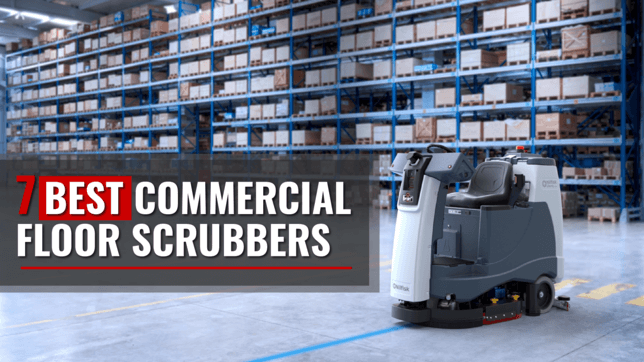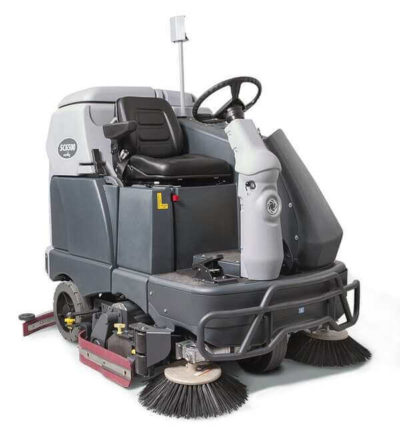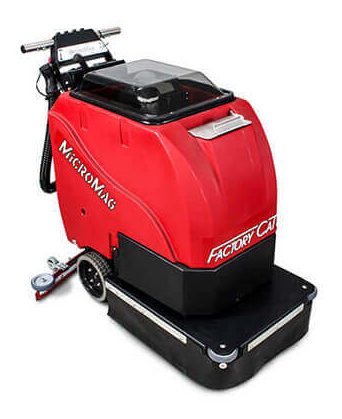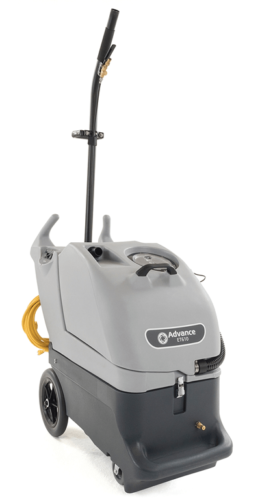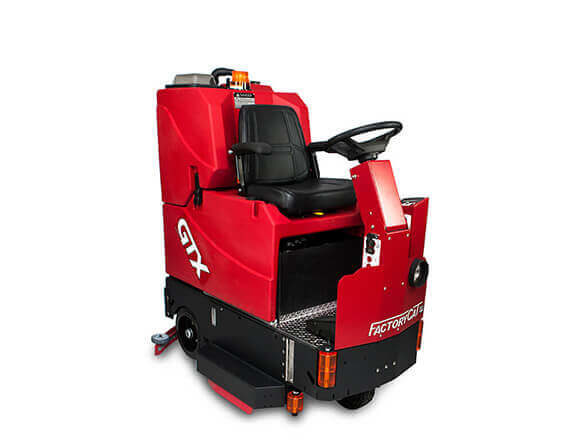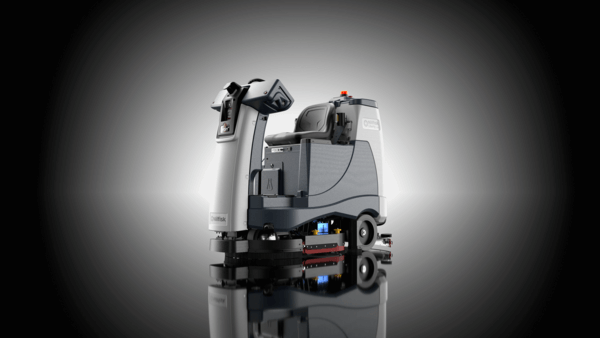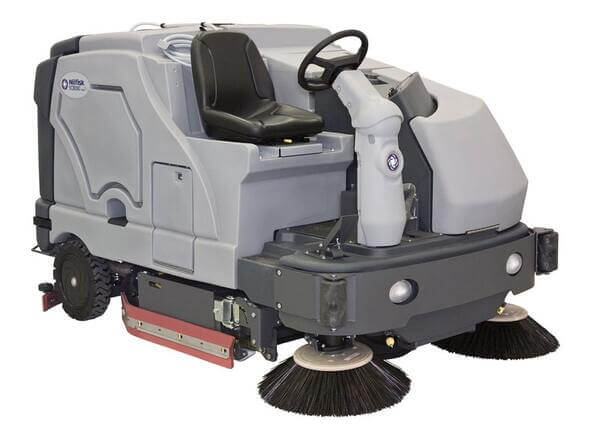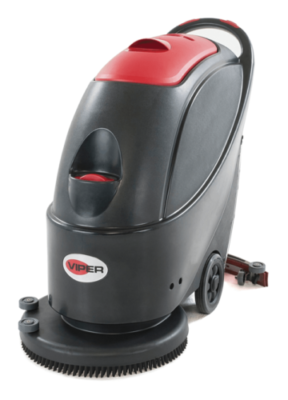This article is all about the best commercial floor scrubbers in 2024.
In it you’ll learn:
- Our picks for the 7 best commercial floor scrubbers
- The different types of floor scrubbers
- The benefits of using a floor scrubber
- How to choose the right floor scrubber
Let’s dive in!
A Quick Look at the 7 Best Commercial Floor Scrubbers
- Best Floor Scrubber for Large Areas: Advance SC6500
- Best Floor Scrubber for Small Areas: Factory Cat MicroMag
- Best Floor Scrubber for Carpets: Advance ET610
- Best Floor Scrubber for Concrete: Factory Cat GTX
- Best Automatic Floor Scrubber: Advance Liberty SC60
- Best Floor Scrubber for Outdoor Use: Advance SC8000
- Best Budget Floor Scrubber: Viper AS430C
Best Floor Scrubber for Large Areas
Advance SC6500
With large and simple-to-understand controls, high-capacity solution and recovery tanks, and your choice of disc or cylindrical scrub decks, the Advance SC6500 rider floor scrubber is perfect for large areas.
Pros
Excellent cleaning productivity with up to 96,800 square feet coverage per hour
Maneuverable with the smallest turning radius among comparable models
Longer life and lower costs with the maintenance-free brushless AC motor
Superior stopping power even on wet surfaces with dual-disc brakes
Technical Specs
- Cleaning productivity: Up to 96,800 square feet per hour
- Cleaning width: Up to 48 inches
- Tank capacity: 70-gallons (solution and recovery)
- Scrub deck type: Disk or cylindrical
- Fuel type: 36-volt electric (battery-powered)
- Propulsion: Self-propelled/traction-drive
- Brush speed: 225-240 RPM (disk); 630 RPM (cylindrical)
- Dimensions: 74 in. (L) x 53-56 in. (W) x 50 in. (H)
- Weight: Up to 3,410 lbs.
Cons
The relatively high cost may be out of reach for smaller companies
Applications
- Warehouses
- Parking garages and lots
- Manufacturing facilities
- College campuses
- Food and beverage
Best Floor Scrubber for Small Areas
Factory Cat MicroMag
We’ve chosen the Factory Cat MicroMag as the best floor scrubber for small areas.
But it may also be the best electric floor scrubber period.
With a robust design for a longer lifespan, a compact footprint for easy maneuverability, and 10-gallon tanks, the MicroMag small commercial floor scrubber is a solid choice for cleaning small areas.
Pros
Efficient deep cleaning with a powerful and heavy-duty 24-volt motor
Longer scrubbing periods with large 10-gallon solution and recovery tanks
Compact and maneuverable with a small minimum aisle turn width for cleaning hard-to-reach areas
Durable and robust design with a 3/16″ powder-coated steel chassis, corrosion-resistant poly tanks, and urethane rollers to protect against impacts
Adaptable to operators with adjustable control panel height
Easy maintenance with tip-back tank offering quick access to batteries, pumps, decks, motors, and hoses
Technical Specs
- Cleaning productivity: Up 2 1/2 hours or 7,308 square feet per tank full
- Cleaning width: 17-inch and 20-inch disk options
- Tank capacity: 10-gallon solution and recovery tanks
- Scrub deck type: Disk
- Fuel type: 24-volt electric (with choice of wet or AGM batteries)
- Propulsion: Pad-assist or traction-drive
- Brush pressure: Up to 100 lbs.
- Brush speed: 200 RPM
- Dimensions: 35 in. (L) x 18 in. (W) x 38 in. (H)
- Weight: Up to 340 lbs.
Cons
Relatively high cost may be expensive for smaller businesses
Applications
- General warehouses
- Automotive dealerships
- Food and beverage
- Fabrication
- Machine shops
Best Floor Scrubber for Carpets
Advance ET610
If you’re looking for a professional carpet-cleaning machine, look no further than the Advance ET610 Carpet Extractor.
Designed with the operator in mind, this machine has large solution and recovery tanks for longer cleaning, an ergonomic design for easier operation and transport, and a high-heat extraction system that uses less water and chemicals while leaving carpets drier.
Pros
Dries quicker and saves on water and chemical use with high-heat cleaning and extraction system
Enhanced durability and longevity with controls and switches isolated from the tank
Easy to transport with ergonomic tank handle, extension cord wraps, and large roller wheels
Simplified draining with sloped recovery tank that allows for complete emptying with ease
Technical Specs
- Cleaning productivity: 500 square feet per hour (with standard 12″ tool); 750 square feet per hour (with upgraded Aquawand)
- Cleaning width: 5.7 inches
- Tank capacity: 12.5-gallon (solution); 11-gallon (recovery)
- Scrub deck type: Cylindrical
- Fuel type: Electric (corded)
- Propulsion: Manual (push-style)
- Dimensions: 40.5 in. (L) x 21 in. (W) x 42 in. (H)
- Weight: 87 lbs.
Cons
No option for battery power means less flexibility with a wall power cord
No option for traction-drive or pad-assist means operators will need to manually propel the machine
Applications
- General carpet cleaning
- Contract cleaners
- Office buildings
- Hospitality facilities
Best Floor Scrubber for Concrete
Factory Cat GTX
The Factory Cat GTX rider floor scrubber is our pick for the best floor scrubber for concrete.
Why?
With a cylindrical deck installed, this commercial hard floor scrubber can pick up debris while simultaneously scrubbing, has high-capacity solution and recovery tanks for longer scrub times, and is built for longevity in mind with a steel chassis and corrosion-resistant poly body.
Pros
Enhanced productivity with up to 4.5 hours of battery life
Eliminates pre-sweeping with cylindrical brushes designed to capture many types of debris
Lower maintenance costs with drain saver basket to catch large debris for easy disposal
Durable design with welded steel frame and heavy-duty poly rollers to protect the scrub deck from damage
Easy operation with a simple control panel that requires minimal training
Technical Specs
- Cleaning productivity: Up to 4.5 hours per full battery charge or 21,661 square feet per hour
- Cleaning width: 26, 28, 30, or 34 in. (disk); 25, 29, or 33 in. (cylindrical); 28 or 32 in. (orbital)
- Tank capacity: 33-gallon (solution); 36-gallon (recovery)
- Scrub deck type: Disk, cylindrical, or orbital
- Fuel type: 36-volt electric (battery-powered)
- Propulsion: Self-propelled/traction-drive
- Brush pressure: Up to 200 lbs.
- Brush speed: 270 RPM (disk); 650 RPM (cylindrical); 2,500 RPM (orbital)
- Dimensions: 66 in. (L) x 34 in. (W) x 64 in. (H)
- Weight: Up to 1,325 lbs.
Cons
With a 34-inch max cleaning path width, it may not be large enough for the biggest concrete floors
Applications
- Food packaging
- Fabrication shops
- Beverage distribution
- Manufacturing
- Sports arenas
Best Automatic Floor Scrubber
Advance Liberty SC60
Have staffing shortages impacted your ability to clean your facility?
Then the Advance Liberty SC60 autonomous floor scrubber may be just what you need.
With the ability to clean floors without an operator present, you no longer need to balance staffing levels with facility cleanliness.
And with advanced floor mapping software, this floor scrubber lets you pre-record cleaning routines – whether for small or large areas.
Pros
Saves on labor costs by carrying out cleaning autonomously
Exemplary runtime with up to 5 1/2 hours of battery life
Minimal input with the ability to record, link, and assign up to 6 pre-recorded cleaning plans
Performance monitoring with regular remote updates
Improves safety and minimizes damage with built-in, path-marking obstacle-detection and avoidance
Quiet operation at 57 decibels for cleaning sensitive areas
Technical Specs
- Cleaning productivity: Up to 5 1/2 hours of battery runtime
- Cleaning width: 28 inches
- Tank capacity: 26.1-gallons (solution); 27.74-gallons (recovery)
- Scrub deck type: Cylindrical
- Fuel type: 24-volt electric (battery-powered)
- Propulsion: Self-propelled/traction-drive
- Brush speed: 250 – 260 RPM
- Dimensions: 66.7 in. (L) x 31.9 in. (W) x 57.5 in. (H)
- Weight: 680 lbs.
Cons
Might be expensive to acquire, especially for small companies
Needs constant internet connectivity
Applications
- Airports
- Supermarkets and shops
- Malls and shopping centers
- General warehouses and logistics
- Health and education facilities
Best Floor Scrubber for Outdoor Use
Advance SC8000
With the ability to clean up to 100,000 square feet on a single tank, the mighty Advance SC8000 is the best heavy-duty floor cleaning machine for outside areas.
And featuring simple controls, advanced water-regulation technology, and a powerful internal combustion engine, this floor scrubber is best equipped to handle the biggest, toughest outside floors you need to clean.
Pros
Unrivaled cleaning productivity with up to 100,000 square feet of coverage on a single tank
Simple controls with OneTouch™ technology allows operators to activate the entire scrub system with a single button
Minimal dust kick-up with the DustGuard™ spray mist system
Easier maintenance with MastAccess™ design that allows 360° access to machine components
Less water consumption with EcoFlex™ technology that automatically adjusts water and chemical usage
Better visibility with ClearView™ design for improved sightlines
Flexible fuel options with LPG or diesel engines available
Technical Specs
- Cleaning productivity: Up to 100,000 square feet per tankful
- Cleaning width: 48-inch, 60-inch, or 62-inch options
- Tank capacity: 100-gallon solution and recovery tanks
- Scrub deck type: Cylindrical
- Fuel type: Internal combustion engine (Kubota LPG or diesel)
- Propulsion: Traction-drive
- Brush pressure: Up to 400 lbs.
- Brush speed: 470 RPM
- Dimensions: 100 in. (L) x 59 in. (W) x 58 in. (H)
- Weight: 3,300 lbs. (empty); 4,200 lbs. (filled)
Cons
High cost may mean it’s out of reach for all but the largest businesses
Large minimum aisle turn width makes it suitable only for wide-open spaces
Heavy weight doesn’t allow for easy transport between sites if needed
Applications
- General warehouses
- Manufacturing plants
- Aircraft hangars
- Beverage distributors
- Food processors
- Wholesalers
Best Budget Floor Scrubber
Viper AS430C
If you’re on a budget and want to reduce your reliance on labor but don’t want to sacrifice performance, the Viper AS430C walk-behind floor scrubber is your best budget option.
With your choice of corded or battery-powered models, simple controls, and large solution and recovery tanks, the Viper AS430C can speed up your floor cleaning operations by a factor of 5 over mop-and-bucket cleaning.
Pros
Affordable with the lowest acquisition cost on this list
High productivity with up to 5X faster floor scrubbing than mop-and-bucket
Versatile scrubbing efficiency for a wide array of applications including heavy-traffic and mid-sized areas
Simple operation with finger-tip controls
Extended runtime with an electric corded option
Improved cleaning range with battery-powered option
Technical Specs
- Cleaning productivity: 12,739 square feet per hour (corded); 15,748 square feet per hour (battery)
- Cleaning width: 17 inches (corded); 20 inches (battery)
- Tank capacity: 13-gallon solution and recovery (corded); 10.5-gallon solution and recovery (battery)
- Scrub deck type: Disk
- Fuel type: Electric – choice of cord or battery-power
- Propulsion: Pad/brush-assist
- Brush pressure: 77 lbs.
- Brush speed: 160 RPM
- Dimensions: 47 in. (L) x 24 in. (W) x 46 in. (H)
- Weight: 154 lbs. (corded); 282 lbs. (battery)
Cons
Doesn’t feature as many advanced options as other, more expensive models on this list
Applications
- Schools
- Hotels
- Restaurants
- Shopping malls
- Retail outlets
- Hospitals
- Metro/train stations
How Commercial Floor Scrubbers Work
In general, commercial floor scrubbers have 4 main components that work together to clean floors.
Let’s briefly go through them.
Solution System
All commercial floor scrubbers have 2 tanks and a pump.
One is the solution tank, which contains water mixed with cleaning solution.
The other is the recovery tank, which stores the used, dirty water.
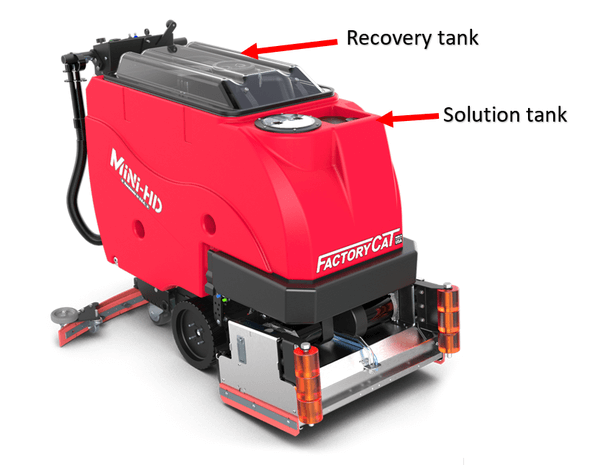
The scrubber’s solution system uses a pump to dispense the cleaning solution from the solution tank into the scrub deck, which contains the scrubbing heads (either brushes or pads).
While the scrub deck dispenses the cleaning solution, the scrubbing heads rotate, which loosens the dirt on the floor.
Recovery System
Once the cleaning solution has been dispensed and the scrub heads have cleaned the floor, the dirty water is sucked up by a vacuum integrated into the rear squeegees.
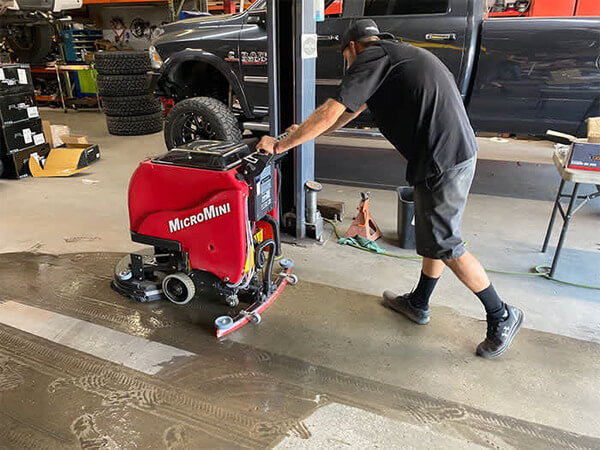
The vacuum system sucks the dirty water up into the recovery tank, and this process continues until the recovery tank is full and needs to be emptied.
Fuel System
What powers a scrubber?
Floor scrubbers can have 3 types of power systems:
-
Cord-powered (electric)
-
Battery-powered (electric)
-
Internal combustion (gasoline, liquified propane gas (LPG), or diesel)
Let’s cover the differences.
Cord-Powered
These scrubbers use a standard electrical cord – much like a vacuum cleaner.
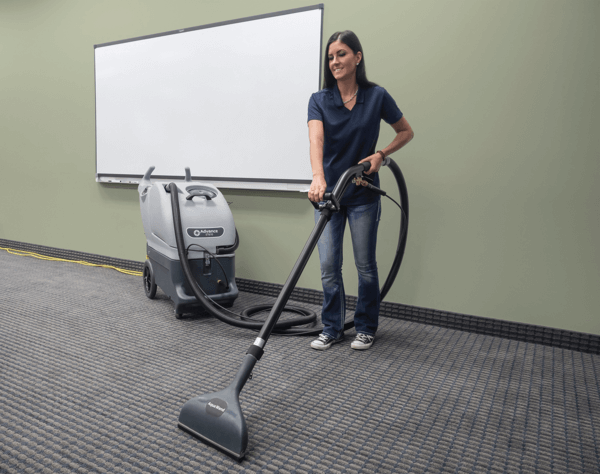
While you don’t have to worry about replacing batteries or refueling with flammable substances, you do have the downsides that come with corded appliances.
That includes limited range, dealing with kinked cords, and an increased tripping hazard.
Battery-Powered
Cordless commercial floor scrubbers run on large lead-acid deep cycle batteries.
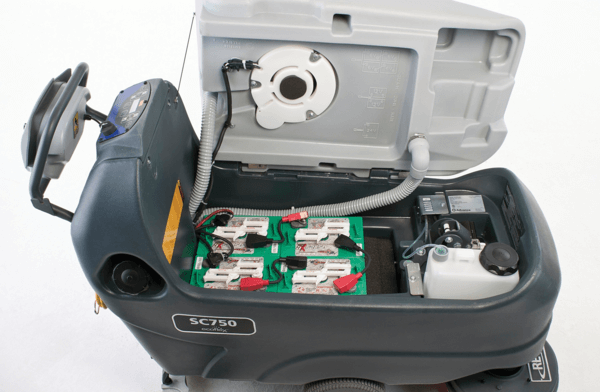
These batteries can be wet/flooded, AGM, or gel.
And while they are rechargeable, they do lose life over time.
Expect to get up to 1,500 charge cycles before you need to replace them.
Battery-powered scrubbers are best for use indoors as they don’t have a noisy internal combustion engine nor do they emit any fumes.
Internal Combustion-Powered
The largest floor scrubbers have engines fueled by either gasoline, LPG, or diesel.
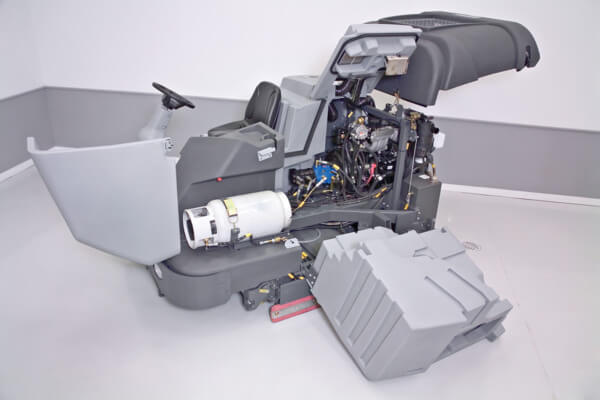
The main advantage of internal combustion floor scrubbers over battery-powered models is that they have longer runtimes.
In fact, if you keep them full of fuel (and maintain them), they can operate nearly continuously.
But, you’ll have more maintenance costs with internal combustion-powered floor scrubbers as they have more moving parts (and more to go wrong).
Propulsion
When we’re talking about floor scrubber propulsion, what we mean is how the machine actually moves.
And that can be done in one of 3 ways:
-
Manual
-
Brush- or pad-assist
-
Traction drive
Let’s go through each type.
Manual Propulsion
The smallest floor scrubbers use manual propulsion.
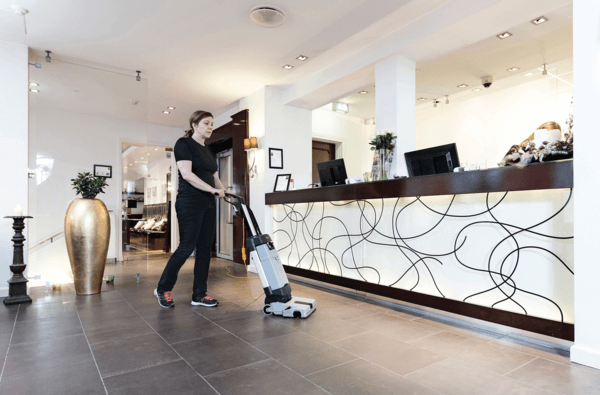
That means they don’t have any mechanism that actually moves the machine along the floor while scrubbing.
Instead, it’s up to the operator to provide the motive force.
Brush- or Pad-Assist
In this type of propulsion, the scrubbing heads themselves actually provide the means for movement.
That is, the spinning brushes or pads also provide the tractive effort to move the floor scrubber along the floor.
Because of this, operators don’t have to expend as much energy, which minimizes fatigue and allows for better productivity.
Traction Drive
A traction-drive floor scrubber is one where the wheels themselves are powered and provide the motive force to move the floor scrubber along the floor.
That makes them much like self-propelled lawnmowers or snow throwers, where the axle is powered and operators control the movement from the control handle.
Or in the case of ride-on floor scrubbers, the operator uses a steering wheel and foot pedals to control the machine.
Types of Floor Scrubbers
There are two main types of floor scrubbers:
- Walk-behind
- Ride-on
Let’s go through each type in more detail.
Walk-Behind Scrubbers
Electric walk-behind floor scrubbers are pretty self-explanatory.
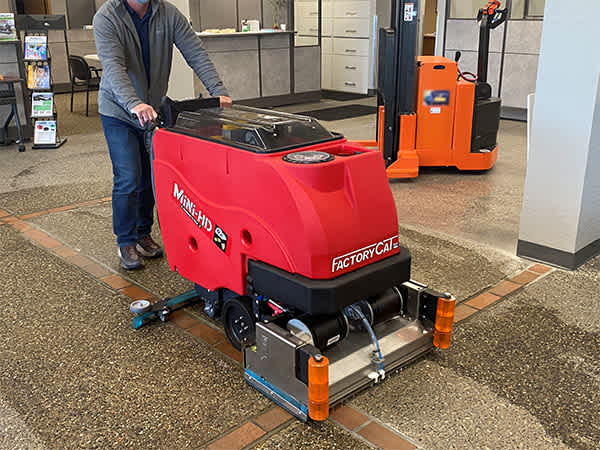
To do the job, the operator stands behind the machine and walks while guiding it.
The operator uses a control panel on the handle to activate the scrubbing system, the vacuum/squeegee, and (in the case of self-propelled machines) the travel speed.
They’re often used in small- and medium-sized commercial applications like offices, schools, and retail outlets.
Quick Facts About Walk-Behind Floor Scrubbers
-
Feature electric power systems, with most battery-powered and some corded
-
Can be propelled manually or automatically through pad- or brush-assist or traction drive
-
Cleaning paths range from 12 inches up to 34 inches
-
Tanks sizes range from less than 1 gallon to 30 gallons
Pros of Walk-Behind Floor Scrubbers
-
Easy to maneuver
-
Do not emit harmful fumes unlike internal combustion scrubbers
-
Clean small areas faster than a mop-and-bucket
-
Are relatively inexpensive
-
Quieter operation for sensitive areas
Cons of Walk-Behind Floor Scrubbers
-
Not ideal for large areas
-
Requires more frequent tank filling and draining than rider scrubbers
Ride-On Scrubbers
Ride-on floor scrubbers allow the operator to sit on the machine while cleaning instead of pushing it.
Using a steering wheel and foot pedals, the operator drives the scrubber around while cleaning – much like a riding lawnmower.
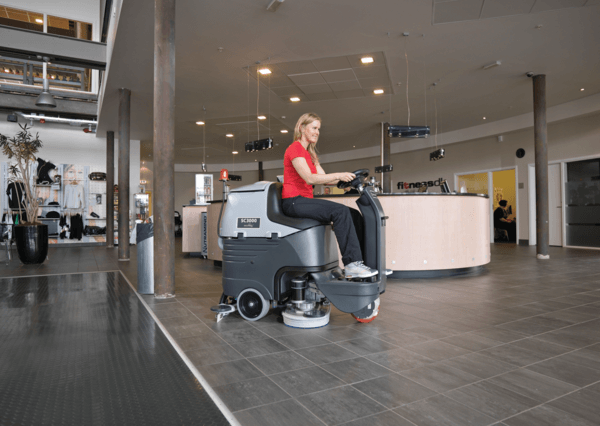
And they manipulate a control panel mounted near the steering wheel to activate the cleaning and recovery systems, control water flow, and adjust the brush/pad pressure.
Overall, rider floor scrubbers are used in large commercial and industrial settings, like manufacturing facilities, warehouses, and parking garages.
Quick Facts About Ride-On Floor Scrubbers
-
Cleaning paths of over 24 inches
-
Tank capacities range from 10 to over 100 gallons
-
Fuel types include electric/battery and internal combustion engines powered by diesel, LPG, or gasoline
Pros of Ride-On Floor Scrubbers
-
Excellent for cleaning large areas and those with lots of dirt and debris
-
Reduces operator fatigue for better productivity
-
Internal combustion-powered rider scrubbers can operate nearly continuously
Cons of Ride-On Floor Scrubbers
-
Not ideal for cleaning small spaces
-
Expensive
-
Need larger space to store
The Benefits of Using a Commercial Floor Scrubber
Whether you’re running a small store or a large industrial complex, a commercial floor scrubber offers many benefits, including:
Labor Savings
Most of the cost associated with using a mop and bucket to clean floors is in the labor.
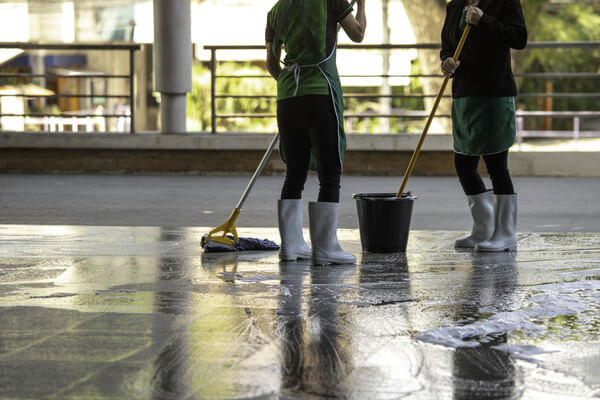
An auto floor scrubber can help reduce the time (and labor) it takes to clean floors, thereby saving you money.
Improved Productivity
Not only does using an auto floor scrubber reduce the amount of time it takes to clean floors, but it also allows for the floor space to be used sooner since they do a better job of drying the floor.
Better Health and Hygiene
Using a mop and bucket means using progressively dirtier water that ends up on the floor.
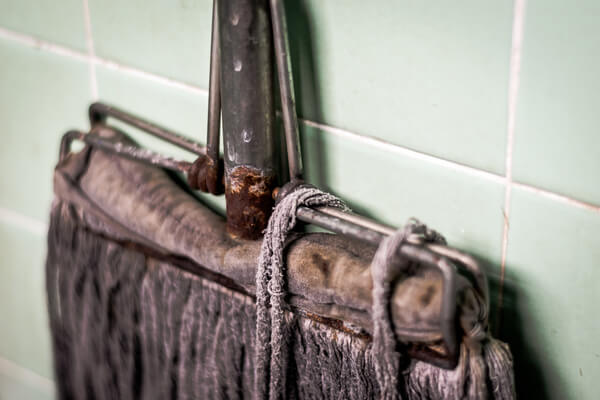
But commercial floor cleaning scrubbers use 100% clean water from the solution tank while all dirty water is collected in the recovery tank.
Reduced Water Usage
Commercial scrubbers use less water compared to manual mopping.
This not only saves on your water bill but is better for the environment.
Enhanced Reputation
Unclean floors can harm your enterprise’s reputation because of the perception that you don’t care about cleanliness.
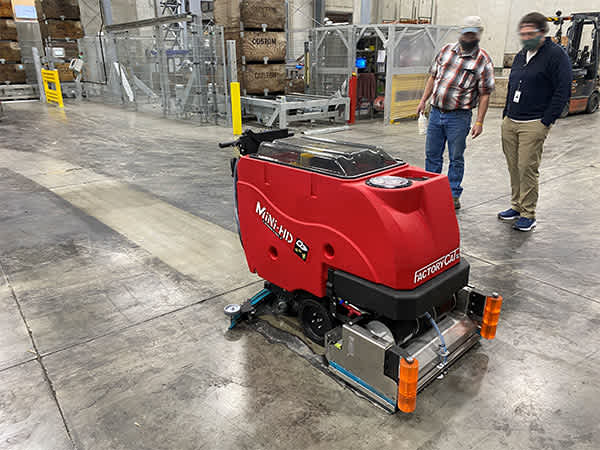
And with labor shortages and staff turnovers, it’s easy to neglect cleaning your floors in favor of other pressing tasks.
But because commercial floor scrubbers clean faster, it’s easier to stay on top of floor cleaning duties – and thus preserve your reputation.
What to Consider When Buying a Floor Scrubber
There are many factors to consider when choosing a floor scrubber.
Use the following checklist to help you make a decision.
Budget
Compared to buying a mop and bucket, a floor scrubber is an expensive investment.
But since most of the cost of floor cleaning is in the labor, a commercial floor scrubber may actually save you money.
Let’s take a quick example…
How Much Can You Save Using a Commercial Floor Scrubber?
Say you clean 12,000 square feet (about the size of a small grocery store) every night.
The average person can mop around 5,000 square feet per hour.
And at $15 per hour, the average labor cost – using a mop and bucket – would be $1,080 per month.
Now, let’s say you decided to lease a small, 17-inch walk-behind floor scrubber – like the Factory Cat MicroMag that’s on this list.
It would cost about $838 per month in labor and leasing costs, potentially saving you $250 every month.
Of course, many factors affect cost savings – and we’ve made a few assumptions in our calculation.
So, it’s best to reach out to a professional who can evaluate your particular facility and give you a closer estimate on what you could save by switching to a floor scrubber.
Space to Clean
You’ll first need to get a clear idea of the total cleanable square footage of your facility.
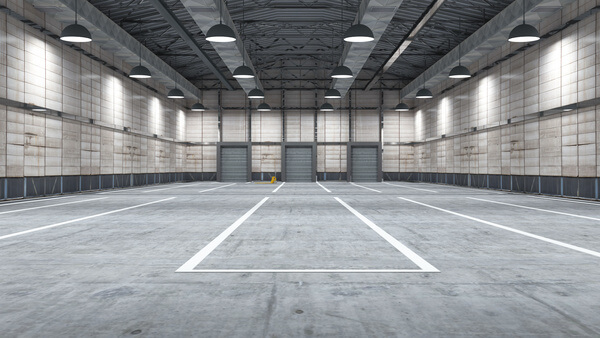
Fortunately, this simple guide will show you exactly how to do it.
Once you have this, you’ll want to compare it to the floor scrubber’s maximum cleaning productivity to ensure it’s close to the space you need to clean.
Two things in particular that you want to pay close attention to are the:
-
Cleaning path
-
Squeegee width
The cleaning path is simply the width of the scrub deck.
You want to have a big enough cleaning width so that you’ll have fewer passes to make, which results in more productive cleaning.
Additionally, you’ll want to check the squeegee width because this is often the widest part of the entire scrubber.
So, while you may choose a scrubber with the cleaning width that will allow you to get into your tightest spaces, you also want to make sure that the squeegee won’t be too big for them.
Floor Type
What kind of floors does your facility have?
Are they smooth and even, like vinyl composition tile (VCT), marble, or terrazzo?
Or are they rough and uneven such as porous concrete or tile with grout?
It’s not so much that these considerations will affect the type of scrubber that you choose, but more that it will dictate the scrub deck that you choose.
For example, disk scrub decks equipped with pads are best for smooth surfaces, since the pads just slide over the floor.
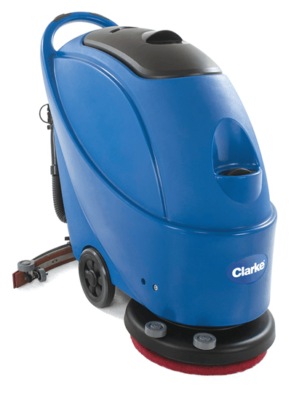
But if you have uneven surfaces or crevices, pores, and grout, you’ll want a brush deck, because the bristles on the brushes allow you to reach into those crevices.
Furthermore, if you have debris on the floor and don’t want to pre-sweep, a cylindrical deck is your best option.
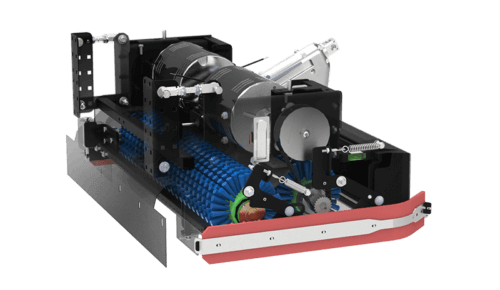
That’s because these decks simultaneously sweep and scrub, saving you the time and hassle of making 2 separate passes to clean the floor.
What’s the moral of the story?
You should consider your floor type and choose a scrubber that can accommodate the particular type of scrub deck that will work best for the type of floors you have.
Fuel Type
We’ve already covered quite a bit about fuel types for floor scrubbers.
And the fact of the matter is, if you’re looking for a smaller scrubber like a walk-behind, you’re going to be limited to battery or cord power.
On the other hand, if you’re looking for a ride-on floor scrubber, you’ll have a choice (depending on the model) between battery-powered or internal combustion.
If you’re primarily working indoors in sensitive applications like office buildings, hospitals, or schools, a battery-powered option is the best bet.
But if you are working outdoors and with large areas like parking garages, an internal combustion model may be a good choice.
Ease of Use and Ergonomics
One thing that each of the floor scrubbers we’ve included in this list has in common is that they’re pretty simple to operate.
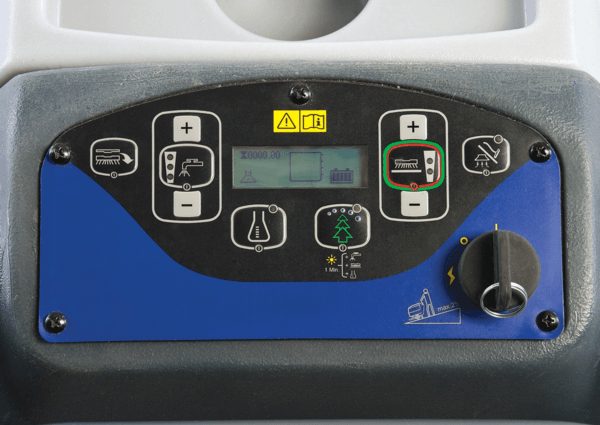
And ease of use and comfort for operators are very important considerations when choosing a floor scrubber.
Some things to keep an eye on are:
-
Ergonomics of the controls. Are they adjustable to accommodate different-sized operators? For ride-on scrubbers, is the seat comfortable?
-
Ease of filling and draining the tanks. Are the tanks easily accessible? Does it require lots of physical effort to drain the recovery tank?
Because, after all, happier operators who have an easier time using the machine will have higher morale and get more done.
Plus, with all the issues with short staffing and high turnover nowadays, you want a machine that takes minimal time to get operators trained on.
One thing you can do is ask your current operators if they have experience with particular floor scrubbing machines.
Another thing is when you’re ready to make a decision, ask the dealership for a demonstration machine.
That way, you can have it brought to your facility to not only ensure that it works for what you need it to but also to see that your operators are comfortable operating it.
Support, Maintenance, and Warranty
Like any piece of equipment, floor scrubbing machines require regular maintenance to keep them running.
A lot of the maintenance, fortunately, is pretty simple and can be done by your operators.
That includes flipping scrub pads or brushes and changing out squeegees.
But for more advanced maintenance, like replacing batteries or wheels, along with making repairs, you want to have a good support system from the place you bought it from.
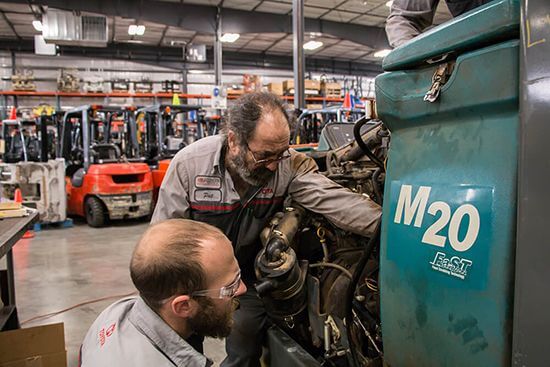
For example, Conger has a robust floor scrubber maintenance program and many qualified technicians with plenty of experience working on these machines.
So, our customers can rely on us to get the machine fixed right, the first time, and put back into service in no time.
Besides maintenance, you also want to ensure that the machine comes with a good warranty.
That way, you can have the peace of mind that if something goes wrong, you won’t be on the hook for repairs.
Available Options
Many manufacturers offer a whole host of options that you can equip your floor scrubber with.
These can include things such as:
-
Accessories. Like handheld wands for cleaning hard-to-reach areas or spray nozzles for cleaning areas the entire machine itself can’t reach
-
Upgraded motors. For higher RPM and greater cleaning effectiveness
-
Adjustable scrubbing pressure. For tackling tough stains or preserving power when doing light cleaning
-
Dilution control. For adjusting the strength of the cleaning solution and conserving chemicals and water
Browse the manufacturer’s website and review their brochures.
And think about which options you think would help boost your productivity, save money, and improve safety.
Facilities for Filling and Emptying the Tanks
Using a floor scrubber means having to regularly fill the solution tank and drain the recovery tank.
And ideally, you’d have a separate area in your facility where these tasks can be performed.
That way, your operators don’t have to interfere with normal operations because your facilities overlap with other areas of production.
You also want to consider any local wastewater regulations.
Since you’ll be regularly releasing wastewater, you don’t want to run afoul of any rules and risk fines as well as environmental damage.
Noise Level
Last but not least, an important – and often overlooked – aspect of floor scrubbers is how noisy they are when operating.
Of course, you don’t want a machine that’s overly loud because it’ll limit your ability to clean sensitive areas during the day, such as offices, schools, and hospitals.
For example, the Advance Liberty autonomous floor scrubber featured in this list comes in at 57 decibels.
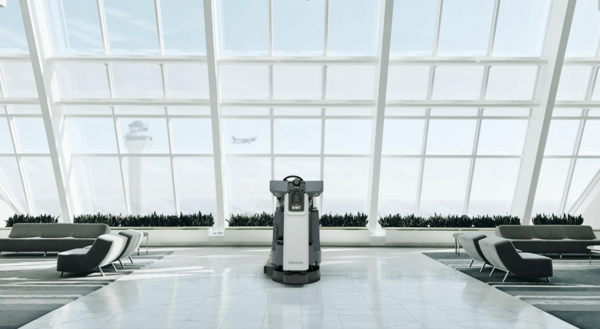
Check the noise level of the floor scrubber and compare it to the areas you’ll be using it in
And that’s about as loud as conversational speech – so it’s suitable for indoor use.
On the other hand, some internal combustion floor scrubbers can reach 84 decibels.
And that’s about as loud as city traffic, which makes them suitable only for outdoor use or in facilities with a comparable ambient noise level (like a foundry).
But besides disturbing people in the area, the noise level can also affect operators.
After all, fatigue can set in, particularly on long shifts, if the machine is too loud and operators aren’t wearing proper ear protection.
Conclusion
That’s it: The 7 best commercial floor scrubbers.
